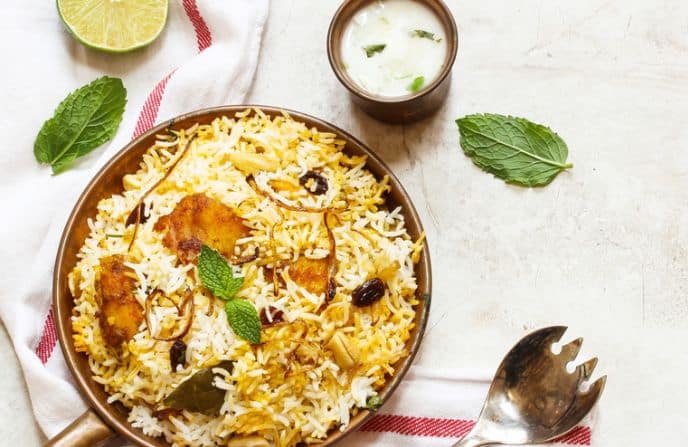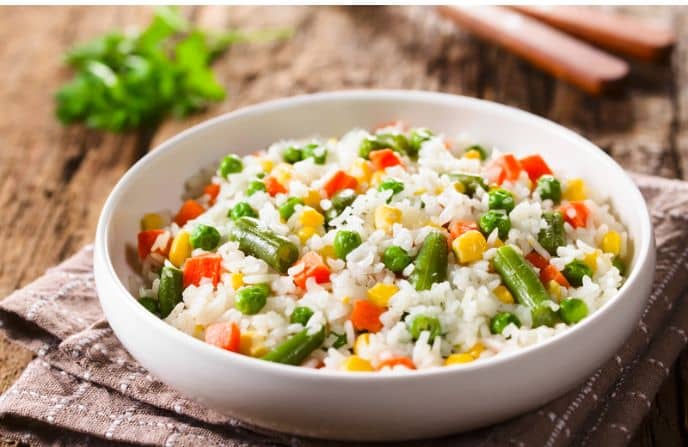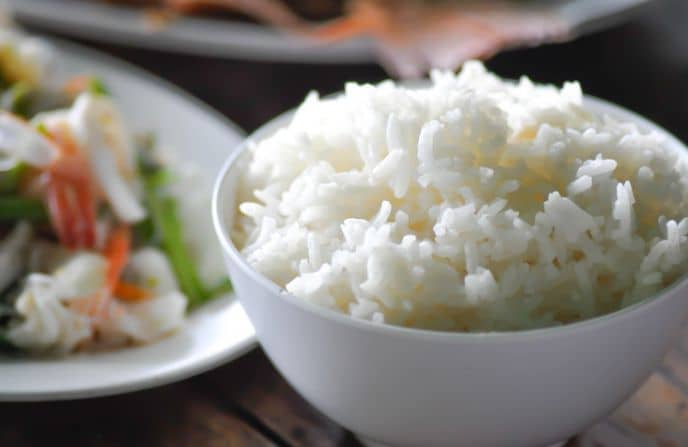Rice is a popular food all over the world, and it’s no wonder why – it’s delicious, versatile, and easy to make. you can enjoy rice as part of a healthy and balanced diet. There’s a lot of conflicting information out there about what’s good for us and what’s not.
Is it bad to eat rice every day? Rice does have some nutritional benefits, but eating rice every day may not be the healthiest option. Rice has a high glycemic index, meaning that it causes blood sugar levels to spike quickly.
In this post, we’ll take a closer look at the pros and cons of eating rice every day, so you can decide for yourself if it’s right for you.
The Benefits And Risks of Eating Rice

Rice has been a staple food in many cultures for centuries, and it is still an important part of the diet in many parts of the world. There are many good reasons to include rice in your diet.
-
Rice is a low-fat food
One of the health benefits of rice is that it is a low-fat food. This means that it can be a good option for those who are trying to lose weight or maintain a healthy weight. Additionally, rice is a good source of complex carbohydrates, which are an important part of a healthy diet.
-
Rice is a good source of vitamins and minerals
Another benefit of eating rice is that it is a good source of vitamins and minerals. Rice contains vitamins B1, B2, and B6, as well as iron, magnesium, and phosphorus. These nutrients are important for maintaining a healthy immune system, metabolism, and energy levels.
-
Rice can help to regulate blood sugar levels
Rice can also help to regulate blood sugar levels. This is because rice has a low glycemic index, which means that it does not cause spikes in blood sugar levels after meals. This can be beneficial for those who have diabetes or are at risk for developing diabetes.
-
Rice may help to protect against heart disease
Some research has also shown that eating rice may help to protect against heart disease. One study found that women who ate at least one serving of white rice per day had a lower risk of developing heart disease than those who ate no rice at all. Additionally, brown rice has been shown to lower cholesterol levels and reduce the risk of stroke.
-
Rice is a versatile food
Another benefit of rice is that it is a versatile food. It can be used in a variety of dishes, including soups, stews, casseroles, and salads. Additionally, rice can be served as a side dish or as the main course of a meal.
The Risks of Eating Too Much Rice

As any rice lover knows, there is no such thing as too much rice. A staple of cuisines around the world, rice is a versatile and delicious grain that can be cooked in endless ways. Plus, it’s affordable and filling, making it a popular choice for budget-conscious eaters. However, some health experts believe that consuming too much rice can lead to weight gain and other problems.
-
Rice is high in carbohydrates and calories
Carbohydrates are an essential part of the human diet, providing the body with a major source of energy. However, not all carbohydrates are created equal. Simple carbs, such as those found in candy and white bread, are quickly broken down by the body and can cause blood sugar spikes. Complex carbs, on the other hand, are slowly digested and provide a more steady source of energy.
Rice is a complex carb that is popular in many cultures around the world. Unfortunately, it is also high in calories and can cause blood sugar spikes if consumed in large quantities. For people who are trying to lose weight or regulate their blood sugar, it is important to limit their intake of rice. However, it can still be enjoyed in moderation as part of a healthy diet.
-
Type 2 diabetes
This is because rice is high in carbohydrates, which can cause blood sugar levels to spike. Over time, this can lead to insulin resistance, which is a major risk factor for diabetes. In addition, people who eat a lot of rice are often also overweight or obese, which further increases their risk of developing diabetes.
While there are many factors that contribute to the development of diabetes, eating a lot of rice is clearly one of them. If you’re concerned about your risk, be sure to talk to your doctor about making dietary changes that can help you lower your risk.
-
Constipation and indigestion
This is because rice contains very little fiber, which is necessary for promoting a healthy digestive system. Without enough fiber, the digestive system slows down and wastes begin to build up in the intestines. In addition to constipation, eating too much rice can also lead to indigestion.
This is because the body has difficulty breaking down all the starch in rice, leading to discomfort and bloating. So while rice can be a healthy part of your diet, it’s important to eat it in moderation to avoid these problems.
-
Rice contains trace amounts of arsenic
Rice is a staple food in many cultures around the world, but it has come under scrutiny in recent years due to its arsenic content. Arsenic is a naturally occurring element that can be found in water, air, and soil. It is also used in some pesticides and industrial chemicals. While trace amounts of arsenic are not harmful, long-term exposure can lead to health problems, including cancer.
The body does not excrete arsenic, so it can build up over time, particularly in people who eat a lot of rice. Therefore, it is important to limit your rice intake or choose rice that has been grown in water with low arsenic levels.
How to Include Rice in Your Diet Without Overdoing It
How Much Rice is Too Much Rice?
This is a question that often plagues those who are trying to eat healthier. According to most experts, the safe limit is about 3-4 cups per day. This amount will provide you with the nutrients you need without overloading you with carbs. Of course, everyone’s body is different and some people may be able to handle more rice than others.
If you are unsure, it is best to start with a smaller portion and work your way up. With a little experimentation, you will soon find the perfect amount of rice for your individual needs.
Tips to Include Rice in Your Diet

Start with a small portion
A cup of cooked rice is about the size of a tennis ball, so start with half of that. You can always have more if you’re still hungry. After all, rice is filling and a little goes a long way. But why stop there? Starting with a small portion of rice can help you to eat less overall. When you fill your plate with rice, your eyes trick you into thinking that you need to eat it all.
However, starting with a small portion allows you to control your portions and avoid overeating. In addition, it can help you to save money by eating less rice overall. So next time you’re at the dinner table, remember to start small and enjoy the benefits of portion control.
-
Pair it with other healthy foods
Rice goes well with lean protein. For example, try pairing it with grilled chicken or fish, sautéed vegetables, or bean soup. Rice can be stir-fried with vegetables and lean protein, such as chicken or shrimp. It can also be used as a base for a healthy soup or stew.
Moreover, rice can be served with beans and greens for a complete meal that is high in fiber and low in fat. And lastly, rice can be enjoyed on its own as a simple side dish. No matter how it is prepared, rice is a healthy food that can help to improve your overall health.
-
Include other healthy carbs in your diet
Carbs have gotten a bad rap in recent years, but the truth is that they are an essential part of a healthy diet. While it’s true that too many carbs can lead to weight gain, there are plenty of healthy carbs that can actually help you lose weight and improve your overall health.
For example, whole grains are a great source of fiber, which helps to keep you feeling full and can even help to reduce cholesterol levels. Other healthy carbs include fruits, vegetables, and legumes, all of which are packed with nutrients and fiber. So if you’re looking to lose weight or improve your health, be sure to include these healthy carbs in your diet.
By following these tips, you can enjoy rice as part of a healthy diet without overdoing it.
Healthy Alternatives to Rice
If you’re looking for healthy alternatives to rice, there are plenty of options to choose from.
-
Brown rice

Brown rice is a whole grain, which means that it contains more fiber and nutrients than white rice. It also has a lower glycemic index, meaning that it won’t cause your blood sugar levels to spike as quickly. In addition, brown rice is more filling than white rice, so you’ll be less likely to overeat. When preparing brown rice, be sure to rinse it thoroughly before cooking. This will help to remove any residual dust or pesticides. Finally, don’t forget to add some extra flavor with herbs or spices.
-
Quinoa

Quinoa is a healthy alternative to rice. It is a complete protein, meaning it contains all nine essential amino acids. Quinoa is also a good source of fiber and magnesium. Additionally, quinoa is gluten-free and has a low glycemic index, making it a good choice for people with celiac disease or diabetes.
Quinoa can be cooked in the same way as rice, making it a versatile addition to any meal. Whether you’re looking for a nutritious side dish or a hearty main course, quinoa is a great choice.
-
Oatmeal

Unlike white rice, which is milled and stripped of its fiber-rich bran and germ, oatmeal is made from whole oats that have been hulled and cleaned. As a result, oatmeal retains much of the fiber and nutrients that are lost during the milling process. In addition, oatmeal is a good source of protein and essential fats, making it a more balanced food than rice.
Oats are naturally low in sugar, so they are less likely to cause spikes in blood sugar levels. For all these reasons, oatmeal is a healthy alternative to rice. And while it may not be as popular as rice, it is sure to gain more fans as people become more health conscious.
-
Cauliflower rice

For those looking to cut down on carbs or add more vegetables to their diet, cauliflower rice is a great option. Made from simply grated or food-processed cauliflower, this low-carbohydrate “rice” can be used in a variety of recipes. It can be stir-fried, made into a pilaf, or even used as a pizza crust.
What’s more, cauliflower rice is a good source of fiber and vitamins, and it contains fewer calories than regular rice. So for those looking for a healthy alternative to rice, cauliflower rice is definitely worth trying.
Conclusion
Rice is a healthy, versatile food that can be included in your diet in many different ways. It’s important to remember not to eat too much rice, especially if you are at risk of developing diabetes or heart disease. With a little creativity, you can enjoy delicious and healthy meals that include rice as a main ingredient.
